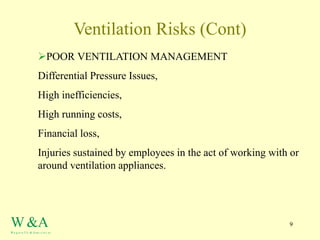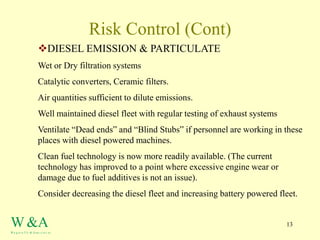Mine_Ventilation_Risks.ppt
- 1. 1 Mine Ventilation Risks & Controls Jason Wagstaffe Wagstaffe & Associates
- 3. 3 Ventilation Hazards Sources of potential harm or situations with a potential to cause loss include Gas Dust & particulate Spontaneous combustion Frictional ignition Windblast Heat Poor / inadequate ventilation Poor ventilation management Inadequate ventilation knowledge W &A W a g st a f f e & Asso c ia t es
- 5. 5 Ventilation Risk Prediction W &A W a g st a f f e & Asso c ia t es Each mine should undertake a Hazard Analysis & Risk Assessment of the Ventilation Hazards. The Hazard Analysis will need to encompass (Not limited to): •Historical records of the mine’s ventilation systems including gas trends •Existing Primary & Auxiliary ventilation systems and its adequacy as the mine expands. •Changes in mining conditions or mine design which may lead to hazards such as Spon.Comb or Outbursts having a greater influence. •Coal seam and adjacent strata properties. •Methods of mining. The magnitude of the risk will determine how to approach the implementation of controls.
- 7. 7 Ventilation Risks W &A W a g st a f f e & Asso c ia t es Ventilation hazards can be broken into their associated risks. GAS Inrush, Outburst, ignition, explosion, asphyxiation. DUST & DIESEL EMISSION & PARTICULATE Airborne dust – Respirable / Inhalable & Dangerous Float Dust. Diesel particulate – Respirable & unknown health issues. SPONTANEOUS COMBUSTION Heating, Fire, Explosion.
- 8. 8 Ventilation Risks (Cont) FRICTIONAL IGNITION Fire, Gas Explosion, Dust Explosion WINDBLAST Damage to ventilation appliances and mine equipment, Personnel injury. HEAT Dehydration, Exhaustion, Injury. POOR / INADEQUATE VENTILATION Frictional Ignition, Spontaneous Combustion, Heat, Dust & Particulate Contamination, Gas issues. W &A W a g st a f f e & Asso c ia t es
- 9. 9 Ventilation Risks (Cont) POOR VENTILATION MANAGEMENT Differential Pressure Issues, High inefficiencies, High running costs, Financial loss, Injuries sustained by employees in the act of working with or around ventilation appliances. W &A W a g st a f f e & Asso c ia t es
- 11. 11 Risk Control W &A W a g st a f f e & Asso c ia t es GAS Regular Inspections to ensure compliance with legislative standards. Well maintained and calibrated gas detection equipment. (Both Hand held, this still includes the Locked Oil Flame Safety Lamp, & telemetric instruments) Sufficient Air quantities for dilution. Gas drainage (where applicable – large gas reservoirs) Gas régime / reservoir modeling Have systems in place that can deal with large quantities of gas if it is required. Management Plan – with triggers and response action plans.
- 12. 12 Risk Control (Cont) DUST Airborne & Respirable Dust controlled via dust extraction units. (New Technology Now Available) Easier to keep dust from becoming suspended then it is to eliminate or control once in suspension. Sprays – machine mounted and fixed systems Wet drilling Too much air velocity can create dust issues. Pre-drained coal may require water injection to assist with dust suppression. An array of ‘Wetting’ agents are available to assist with dust suppression. Limit employee exposure to dust. W &A W a g st a f f e & Asso c ia t es
- 13. 13 Risk Control (Cont) DIESEL EMISSION & PARTICULATE Wet or Dry filtration systems Catalytic converters, Ceramic filters. Air quantities sufficient to dilute emissions. Well maintained diesel fleet with regular testing of exhaust systems Ventilate “Dead ends” and “Blind Stubs” if personnel are working in these places with diesel powered machines. Clean fuel technology is now more readily available. (The current technology has improved to a point where excessive engine wear or damage due to fuel additives is not an issue). Consider decreasing the diesel fleet and increasing battery powered fleet. W &A W a g st a f f e & Asso c ia t es
- 14. 14 Risk Control (Cont) SPONTANEOUS COMBUSTION Regular inspections using both handheld detection equipment and body senses. (Mine Inspection System) Mine Design / Ventilation Layout must take Spon. Comb. into consideration. Long term air stream analysis trending. Tube bundle gas detection systems may be worth considering. Ventilation pressures need to be watched carefully. High differential pressures across pillars and slack coal will cause issues. Ventilation Appliances need to be well maintained. Management Plan - Triggers and Response Action Plans. W &A W a g st a f f e & Asso c ia t es
- 15. 15 Risk Control (Cont) FRICTIONAL IGNITION Sharp Cutting Picks Good sprays Air velocities capable of eliminating accumulations of gas Operators must trained and be vigilant. Regular revision of training for operators will assist in maintaining knowledge base. Try not to cut roof / floor stone Minimise depth of cut in high flammable gas zones Ready access to fire fighting equipment in working order. Management Plan. W &A W a g st a f f e & Asso c ia t es
- 16. 16 Risk Control (Cont) WINDBLAST High standard of ventilation appliances required. Mine plan needs to focus on minimising the windblast effect by having multiple entries / exits for air to travel. Consider pressure relief doors in appliances that are adjacent to Windblast zone areas. Operators need to be vigilant. Management Plan - Triggers and Response Action Plans. W &A W a g st a f f e & Asso c ia t es
- 17. 17 Risk Control (Cont) HEAT Maintain reasonable air velocities for cooling effect. Minimise radiated heat. Especially in single entries. Operators must be educated in hydration principles. Regular humidity checks and monitoring. Consider installation of hydraulically driven fans for roof bolting machines to create cooling velocities for operators. Management must understand the physiological issued that are created when heat is an issue. Consider air refrigeration. W &A W a g st a f f e & Asso c ia t es
- 18. 18 Risk Control (Cont) VENTILATION CONTROLS Include, but are not limited to: Auxiliary Fans Dust Extractors Regulators Overcasts Permanent & Temporary Stoppings. Venturi’s Brattice Booster Fans – Small & Large W &A W a g st a f f e & Asso c ia t es
- 19. 19 Risk Control (Cont) VENTILATION STRUCTURE INTEGRITY Structures include Seals, Permanent & Temporary Stoppings and overcasts. Structure integrity is critical for operations that mine seams with large gas reservoirs or have a propensity for Spontaneous Combustion. Consider ‘Keying’ into ribs to ensure minimal leakage past structures. Consider Grouting or P.U.R. injection of coal pillars to assist with structure integrity. Especially in areas of high differential pressure. W &A W a g st a f f e & Asso c ia t es
- 20. 20 Risk Control (Cont) MINES DEPARTMENT GUIDELINES 1999 - Mineral Resources Released DRAFT version of MDG 1023 “Ventilation Control System Guideline” for comment. Prepared by Dr. Roy Moreby – Associate Professor UNSW No longer listed on the Department list of available guidelines. A useful tool in developing a systematic approach to ventilation risk control. MDG 1003 – Windblast Code of Practice MDG 1006 – Spontaneous Combustion Management Code W &A W a g st a f f e & Asso c ia t es
- 21. 21 Risk Control (Cont) VENTILATION MANAGEMENT PLANS Need to be short and concise, but contain all the information a person will need to manage the individual risk/s. The reasoning that went into the creation of the Management Plan needs to be documented , but doesn’t need to appear in the Management Plan itself. Only work if people read and UNDERSTAND them. Not just the Domain of the “Ventilation Officer” W &A W a g st a f f e & Asso c ia t es
- 22. 22 Hierarchy of Error INADEQUATE VENTILATION KNOWLEDGE POOR VENTILATION MANAGEMENT POOR / INADEQUATE VENTILATION LOSS HUMAN & FINANCIAL W &A W a g st a f f e & Asso c ia t es
- 23. 23 Conclusion Ensure suitable knowledge base – No.1 Priority Design and implement management plans that work. Note: Good, effective management plans do not need reams of paper. Allow time and resources to implement plans. Train effectively & regularly. Check that management plans work by regular auditing. Choose auditors wisely and allow time and resources for those people to be effective. EFFECTIVE MANAGEMENT PLANS WILL SAVE YOUR MINE MONEY W &A W a g st a f f e & Asso c ia t es























